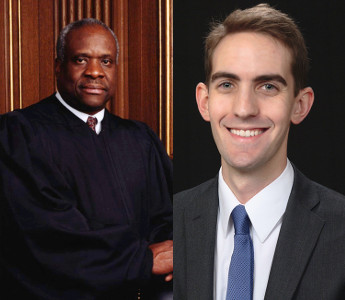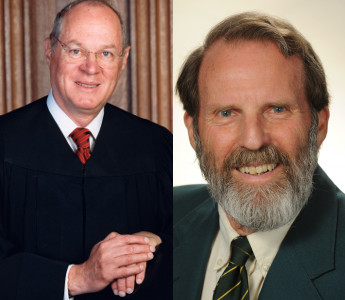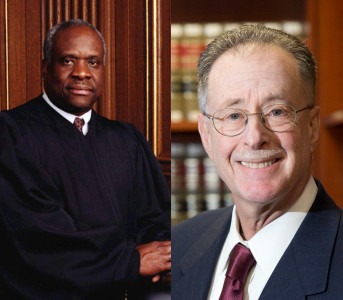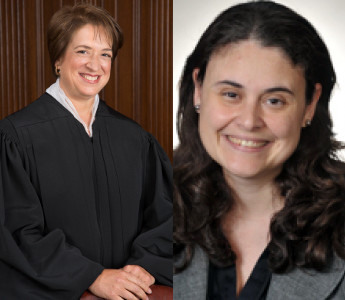Whole Woman’s Health v. Hellerstedt, 579 U.S. ___ (2016) (Breyer, J.).
Response by Steven Aden
Geo. Wash. L. Rev. On the Docket (Oct. Term 2015)
Slip Opinion | New York Times | SCOTUSblog
The Silence of Justice Kennedy and the Future of Abortion Jurisprudence
There were several “big stories” in the Supreme Court’s abortion decision Monday, Whole Woman’s Health v. Hellerstedt.1 The biggest of all, I think, was the silence of Justice Anthony Kennedy. Kennedy had made no secret of his personal antipathy toward abortion in previous cases, and of his solicitude for the rights of those who believe it to be a “grievous moral wrong.”2 His descriptions of late-term abortion in his dissent in Stenberg v. Carhart,3 and for the Court in Gonzales v. Carhart,4 left no doubt, we thought, that he was in moral agreement with critics of the practice. But given the opportunity to speak with clarity and force on an issue we thought he cared deeply about, as he did last week for the Court in Fisher v. University of Texas,5 he not only passed the writing of the Court’s opinion to Justice Stephen Breyer, a known abortion advocate, but he himself did not write. As a result, the rather jarring difference between the almost Puritanical tone of the Court in the 5-4 split decision in Gonzales, and Hellerstedt’s cynical, thoroughgoing search for data to validate the State’s impositions on a fundamental right can be explained, as it nearly always is in this area of law, by the fact that one Justice firmly sits between those two positions.
Another significant surprise was the majority’s determination to view Texas’s health and safety provisions as new impositions on the practice of abortion, and hence bootstrap the analysis by essentially placing the burden on the State to justify them. The majority took the benchmark as the state of the Texas regulations before the passage of HB2, rather than what it should have been, which was the state of the standard of practice for outpatient surgical care in Texas. There was ample evidence on this point, if the majority had desired to look for it. For instance, who says admitting privileges are a standard of practice for outpatient surgical providers? The American Association for Accreditation of Ambulatory Surgery Facilities, Inc. (AAASF), for one, which accredits more than 2000 outpatient facilities.6 The State’s health director, Mikeal Love, M.D., testified in the facial decision, Abbott,7 that “[r]equiring hospital admitting privileges for physicians who perform abortions is the general standard of care,” and “consistent with the way medicine has been practiced for over 100 years.” And Justice Kennedy appeared to be saying the same thing in Stenberg, when he observed that the respondent was an “abortionist” who “lack[ed] admitting privileges at any hospital.”8 Even if HB2 represented new impositions, though, the Court had previously recognized that abortion may be regulated differently than other medical procedures.9 There was no intimation of that principle here, however.
Gone also, it seems, was Gonzalez’s affirmation of the well-accepted rule that states have “wide discretion” in passing health and safety legislation, even if “medical and scientific uncertainty” exists.10 The majority seems to have taken up again its position as “the country’s ex officio medical board with powers to approve or disapprove medical and operative practices and standards throughout the United States.”11 Under Casey, the Court had declined to perform the legislative role that would be the essence of such judicial oversight–balancing the medical justifications of regulations against their putative burdens. Casey itself upheld a requirement that a physician provide the patient with informed consent information “even if an objective assessment might suggest that those same tasks could be performed by others.”12 When the Supreme Court undertakes this task, it tends to do so badly; witness its affirmation that saline abortion, a practice long since abandoned as dangerous to women, is a constitutionally protected means of abortions in Planned Parenthood of Central Missouri v. Danforth.13
Justice Breyer claimed for the Court in Hellerstedt, “Moreover, many surgical-center requirements are inappropriate as applied to surgical abortions . . . [A]bortions typically involve either the administration of medicines or procedures performed through the natural opening of the birth canal, which is itself not sterile.”14 But in passing the ASC requirements, the Texas legislature relied upon testimony that surgical abortion should be performed in a sterile environment because it involves entry into the sterile uterus, and that procedures requiring entry into the uterus, such as dilation and curettage, are traditionally performed in ASC or hospital settings. Likewise, it appears to have eluded the majority that the practice of surgical abortion overwhelmingly occurs in outpatient clinical facilities like ASC’s, not hospitals or doctors’ offices, as a leading treatise and the pro-abortion Guttmacher Institute agrees.15 Although abortion practice is similar to procedures typically performed in ASCs such as cataract surgery, upper gastrointestinal endoscopy, colonoscopy and spinal injection,16 the majority has set abortion apart as inherently safer. Complication and hospitalization rates are significant, also, according to uncontroverted testimony. The frequency of perforating the uterus at the time of first trimester surgical abortion has been estimated to vary between .08% to 3%,17 and the overall hospitalization rate for abortion is 0.3%.18 Thus, for a year such as 2012 in which Texas reported 68,298 abortions, the state should expect to see approximately 204 abortion patients hospitalized for complications, a figure that is consistent with the number of 210 annual hospitalizations acknowledged by one of the plaintiffs in Abbott II.19
Hellerstedt may also tend to obfuscate, not clarify, the meaning of the Casey “undue burden” test. Before Hellerstedt, many believed, with Judge Manion on the Seventh Circuit and Judge Garza on the Fifth, that Gonzales essentially “simplified Casey’s description of an undue burden by collapsing the purpose inquiry into the effects test.”20 But the Hellerstedt majority seems to have rejected the notion that Casey must be interpreted to embrace mere rational basis a la Williamson v. Lee Optical21 in considering abortion regulations. “Reasonableness,” per the majority, is the watchword for abortion and other “liberty interests,” but it appears to be reasonableness with muscle. The district court had concluded that the admitting privileges requirement “surmount[s] the low bar of rational-basis review.”22 But the majority vaunts “reasonableness” into a sphere it was never intended to inhabit; while the plaintiffs quoted Casey’s statement that “[u]nnecessary health regulations that have the purpose or effect of presenting a substantial obstacle” are unconstitutional,23 the Court has not used the term “unnecessary” literally to mean “not required,” but simply as a proxy for “unreasonable.” In fact, the Court had never used the phrase “unnecessary health regulations” in another abortion case and there was no reason to believe that it adds an additional layer of scrutiny beyond the established undue-burden test articulated in Casey, as well as Gonzales and Mazurek.24 To the contrary, outside the abortion context but within the (presumably) equally important liberty interest in privacy, “[s]tate legislation which has some effect on individual liberty or privacy may not be held unconstitutional simply because a court finds it unnecessary, in whole or in part.”25
Next, there is the seemingly absolute shipwreck of the “large fraction test.” Justice Alito said what many of us had been thinking for a long time: that when abortion advocates articulate the test, it comes out a “heads I win, tails you lose” deal:
The Court, by contrast, applies the “large fraction” standard without even acknowledging the open question. In a similar vein, it holds that the fraction’s “relevant denominator is ‘those [women] for whom [the provision] is an actual rather than an irrelevant restriction.’” Ibid. (quoting Casey, 505 U.S., at 895, 112 S.Ct. 2791). I must confess that I do not understand this holding. The purpose of the large-fraction analysis, presumably, is to compare the number of women actually burdened with the number potentially burdened. Under the Court’s holding, we are supposed to use the same figure (women actually burdened) as both the numerator and the denominator. By my math, that fraction is always “1,” which is pretty large as fractions go.26
Then there is the question of closures and capacity. The plaintiffs claimed, of course, that they would close if forced to comply with the surgical center regulations and that the admitting privileges and surgical center requirements were the driving force in bringing the number of Texas abortion facilities from forty down to eight, and the Court agreed. “In our view, the record contains sufficient evidence that the admitting-privileges requirement led to the closure of half of Texas’ clinics, or thereabouts,” said Justice Breyer.27 But the majority ignored extensive evidence that Texas put on that clinics were closing for other reasons, including market competition, the drop in demand, and consolidation.28 In fact, plaintiff Whole Woman’s Health’s owner, Amy Hagstrom-Miller, complained about the business practices of her chain’s biggest competitor, Planned Parenthood, in the Wall Street Journal, stating that the abortion giant’s advantages made it hard for her to compete and keep her doors open.29 Demand for abortion nationally has dropped precipitously since Casey based on a variety of factors.30 By and large, the majority chose not to grapple with any reasons for closures that did not fit within the abortion providers’ narrative. “At least nine Texas clinics may have ceased performing abortions (or reduced capacity) for one or more of the reasons having nothing to do with the provisions challenged here,” Justice Alito concluded.31 The majority’s seeming view that “thereabouts” was a close enough measure to find an “undue burden” says quite a bit about their view of what the “undue burden” standard means.
Of course, there was the puzzling failure of the majority to show any desire to parse the manifold ambulatory surgical center regulations for constitutionality, in violation of the letter and spirit of Ayotte v. Planned Parenthood,32 in which the Court had said unanimously that ordinarily it would not invalidate entire sections of abortion control regulations, but would consider them on a case-by-case basis. Throughout the litigation, the plaintiffs never identified which ASC regulations would require them to close and which were reasonable. In spite of that, the Fifth Circuit granted as-applied relief to the McAllen facility from two components of the ASC regulations: the physical-plant and fire-prevention requirements.33 But many of the regulations imposed no real burden and were consistent with procedures that outpatient clinics should already voluntarily have in place. For example, the regulations establish patient rights, including the right to be “treated with respect, consideration, and dignity,” to be “provided with appropriate privacy,” to be provided with “appropriate information concerning their diagnosis, treatment, and prognosis,” and a host of other commonsense provisions.34 By eschewing to decide which provisions actually imposed an “undue burden,” the majority calls into question whether that term has any real meaning.
So after Hellerstedt, what is the rule? The majority appears to be saying that provisions that have the effect of shuttering a substantial number of abortion facilities will be regarded as imposing an undue burden on access unless the State can demonstrate a compelling need for them. That’s almost certainly the view of Justices Ginsburg, Breyer, Sotomayor, and Kagan. But that wasn’t the view of Justice Kennedy, at least not if you read his opinion in Gonzales v. Carhart and the plurality opinion he joined in Planned Parenthood v. Casey. And on the other side of the ideological spectrum, you have likely three votes (Chief Justice Roberts and Justices Thomas and Alito) who would like to scrap Roe.35
It would be best to remember, that the “rule” is what Justice Kennedy, at least for now, says it is. And on that point, he’s chosen to remain silent. It may be that, as a longtime fellow abortion litigator friend of mine believes, Justice Kennedy tamped down Justice Breyer’s rhetoric a bit, and kept it from sounding like a constitutional balancing test. Time may tell. Time has a habit of getting away from us, however, as Justice Antonin Scalia’s absence from the Court reminds us.36 For now, Justice Kennedy’s silence virtually guarantees that litigators on both sides of the issue—state’s counsel, abortion rights advocates, and pro-life trial lawyers—will keep on thrashing out the meaning of Casey and Hellerstedt in a variety of regulative contexts, including twenty-week pain-capable bans, transfer agreements, reporting requirements and more modest, tactically-oriented surgical center requirements (particularly in the area of “medical,” or RU-486 abortions).
Steven Aden was counsel of record on an amicus curiae brief filed in support of the respondent in Whole Woman’s Health v. Hellerstedt. The opinions expressed in this response are his own and do not reflect the position or beliefs of The George Washington Law Review, the George Washington University, or any other affiliated party.
Steve Aden is senior counsel for Alliance Defending Freedom. Since joining ADF in 2008, Aden has focused his litigation efforts on the sanctity of human life, free speech on public university campuses, and the constitutionality of faith-based initiatives. Aden has also authored numerous law review articles on constitutional law and civil rights, and is a frequent media commentator.
- Whole Women’s Health v. Hellerstedt, No. 15-274, slip op. (U.S. June 27, 2016).
- Hill v. Colorado, 530 U.S. 703, 792 (2000).
- Gonzales v. Carhart, 50 U.S. 128 (2007).
- Stenberg v. Carhart, 530 U.S. 914 (2000) (Kennedy, J., dissenting).
- Fisher v. Univ. of Tex., No. 14–981, slip op. (U.S. June 23, 2016)
- See Am. Ass’n for Accreditation of Ambulatory Surgery Facilities, v14.4 Surgical Standards 71, http://www.aaaasf.org/docs/default-source/accreditation/standards/standards-manual-and-checklist-v14-(obs).pdf?sfvrsn=9.
- Declaration of Mikeal Love, M.D. at 3, Planned Parenthood of Greater Texas Surgical Health Servs. v. Abbott, 951 F. Supp. 2d 891 (W.D. Tex. 2013) (Civ. No. 1:13-cv-862-LY).
- Stenberg, 530 U.S. at 958 (Kennedy, J., dissenting).
- See, e.g., Harris v. McRae, 448 U.S. 297, 325 (1980).
- Gonzales v. Carhart, 50 U.S. 128, 163 (2007).
- Id. at 162-64 (internal quotation marks and citation omitted).
- Planned Parenthood of Se. Pa. v. Casey, 505 U.S. 833, 885 (1992); see also Mazurek v. Armstrong, 520 U.S. 968, 973 (1997) (upholding a requirement that abortions be performed by physicians, even though “the only extant study comparing the complication rates for first-trimester abortions performed by [physician assistants] with those for first-trimester abortions performed by physicians found no significant difference”); Gonzales, 550 U.S. at 158 (upholding a ban on partial-birth abortion without conducting a balancing analysis, requiring only that the State have “a rational basis to act” and that it not “impose an undue burden”).
- See Planned Parenthood of Cent. Mo. v. Danforth, 428 U.S. 52, 79 (1976). See also Cassing Hammond, Recent Advances in Second-Trimester Abortion: An Evidence-Based Review, 200 Am. J. of Ob. & Gyn. 347, 350 (April 2009) (“Hypertonic saline, the first agent commonly used for intraamniotic termination, became the mainstay of second-trimester medical abortion through the 1970s, although most physicians have abandoned its use because of risks such as hypernatremia, coagulopathy, and massive hemorrhage.”)
- Whole Women’s Health v. Hellerstedt, No. 15-274, slip op. at 31 (U.S. June 27, 2016).
- See Te Linde’s Operative Gynecology 448 (John J. Rock, Jr. & Howard W. Jones, III eds. 2003) (reporting that 93% of abortions occur in free-standing clinics and 2% in physicians’ offices); Rachel K. Jones & Jenna Jerman, Abortion Incidence and Service Availability in the United States, 2011 , 46 Persp. on Sexual and Reprod. Health 3, (2014), http://www.guttmacher.org/pubs/journals/psrh.46e0414.pdf.
- See Carrie Pallardy & Scott Becker, 50 Things to Know About the Ambulatory Surgery Center Industry, Becker’s ASC Rev. (Jul. 20, 2013), http://www.beckerasc.com /lists/50-things-to-know-about-the-ambulatory-surgery-center-industry.html.
- Steven G. Kaai, Ivan A. Szigetvari, & George S. Bartfai, The Frequency and Management of Uterine Performations During First-Trimester Abortions, 161 Am. J. Obstet. Gynecol. 406 (1989). The overall hospitalization rate following elective abortion (one in three hundred patients) is similar to rates for other invasive outpatient procedures such as liposuction, gastrointestinal endoscopy such as colonoscopy and upper endoscopy. Ctrs. for Disease Control, Nat’l Health Statistics Reports: Ambulatory Surgery in the United States, No. 11 (Jan. 28, 2009, revised Sept. 4, 2009).
- Stanley K. Henshaw & Lawrence B. Finer, The Accessibility of Abortion Services in the U.S., 2001, 35 Persp. on Sexual and Reprod. Health 16 (2003).
- Planned Parenthood of Greater Tex. Surgical Health Servs. v. Abbott, 748 F.3d 583, 595 (5th Cir. 2014) [hereinafter Abbott II].
- Planned Parenthood of Wisc., Inc. v. Schimel, 806 F.3d 908, 930 (7th Cir. 2015) (Manion, J., dissenting); accord Jackson Women’s Health Org. v. Currier, 760 F.3d 448, 460 n.4 (Garza, J., dissenting).
- Williamson v. Lee Optical, 348 U.S. 483, 491 (1955); See Whole Women’s Health v. Hellerstedt, No. 15-274, slip op. at 20 (U.S. June 27, 2016).
- Whole Woman’s Health v. Lakey, 46 F. Supp. 673, 680 (W.D. Tex. 2014).
- Brief of Petitioners at i, Hellerstedt, No. 15-274 (U.S. June 27, 2016).
- See Gonzales v. Carhart, 50 U.S. 128, 158 (2007) at 158; Mazurek v. Armstrong, 520 U.S. 968, 971 (1997).
- Whalen v. Roe, 429 U.S. 589, 597 (1977).
- Hellerstedt, slip op. at 24, n.11 (Alito, J., dissenting).
- Id. at 26 (majority opinion).
- See Id. at 15, n.9 (Alito, J., dissenting).
- Stephanie Simon, Planned Parenthood Hits Suburbia, Wall St. J. Online (June 23, 2008), http://online.wsj.com/news/articles/SB121417762585295459. See also Steven H. Aden, Driving Out Bad Medicine: How State Regulation Impacts the Supply and Demand of Abortion, 8 UST. J.L. & Pub. Pol’y 14, 23, nn.60–62 (2013).
- See Madeleine Schwartz, Abortion Clinics in Blue States Are Closing Too, FiveThirtyEight (May 2, 2013), http://fivethirtyeight.com/features/abortion-clinics-in-blue-states-are-closing-too/ (citing declining demand, inelasticity of abortion prices and aging abortion providers as reasons facilities in pro-abortion states are closing).
- Hellerstedt, slip op. at 28 (Alito, J., dissenting).
- Ayotte v. Planned Parenthood, 546 U.S. 320, 331 (2006).
- Whole Woman’s Health v. Cole, 790 F.3d 563, 596 (5th Cir. 2015).
- 25 Tex. Admin. Code Ann. § 135.5.
- Roe v. Wade, 410 U. S. 113 (1973).
- Justice Kennedy’s cautionary words, “In a fleeting existence we have but little time to find truth through discourse,” Hill v. Colorado, 530 U.S. 703, 792 (2000), are brought to mind here.
Recommended Citation:
Steven Aden, Response, Whole Woman’s Health v. Hellerstedt: The Silence of Justice Kennedy and the Future of Abortion Jurisprudence, Geo. Wash. L. Rev. On the Docket (July 3, 2016), http://www.gwlr.org/whole-womans-health-v-hellerstedt-the-silence-of-justice-kennedy-and-the-future-of-abortion-jurisprudence/.





